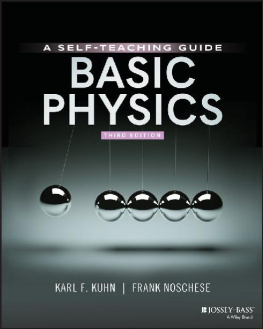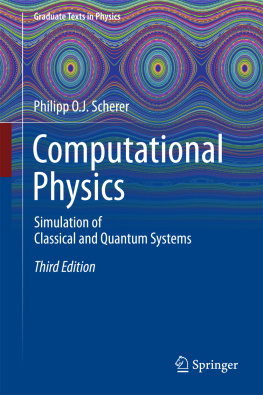Benjamin A. Stickler - Basic Concepts in Computational Physics
Here you can read online Benjamin A. Stickler - Basic Concepts in Computational Physics full text of the book (entire story) in english for free. Download pdf and epub, get meaning, cover and reviews about this ebook. year: 0, publisher: Springer International Publishing, genre: Children. Description of the work, (preface) as well as reviews are available. Best literature library LitArk.com created for fans of good reading and offers a wide selection of genres:
Romance novel
Science fiction
Adventure
Detective
Science
History
Home and family
Prose
Art
Politics
Computer
Non-fiction
Religion
Business
Children
Humor
Choose a favorite category and find really read worthwhile books. Enjoy immersion in the world of imagination, feel the emotions of the characters or learn something new for yourself, make an fascinating discovery.
- Book:Basic Concepts in Computational Physics
- Author:
- Publisher:Springer International Publishing
- Genre:
- Year:0
- Rating:5 / 5
- Favourites:Add to favourites
- Your mark:
- 100
- 1
- 2
- 3
- 4
- 5
Basic Concepts in Computational Physics: summary, description and annotation
We offer to read an annotation, description, summary or preface (depends on what the author of the book "Basic Concepts in Computational Physics" wrote himself). If you haven't found the necessary information about the book — write in the comments, we will try to find it.
Basic Concepts in Computational Physics — read online for free the complete book (whole text) full work
Below is the text of the book, divided by pages. System saving the place of the last page read, allows you to conveniently read the book "Basic Concepts in Computational Physics" online for free, without having to search again every time where you left off. Put a bookmark, and you can go to the page where you finished reading at any time.
Font size:
Interval:
Bookmark:


This Springer imprint is published by Springer Nature
The registered company is Springer International Publishing AG Switzerland
Direct simulation of physical processes such as
Molecular dynamics or
Monte Carlo simulation of physical processes
Solution of complex mathematical problems such as
Differential equations
Minimization problems
High-dimensional integrals or sums
This book addresses all these scenarios on a very basic level. It is addressed to lecturers who will have to teach a basic course/basic courses in Computational Physics or numerical methods and to students as a companion in their first steps into the realm of this fascinating field of modern research. Following these intentions this book was divided into two parts. Part I deals with deterministic methods in Computational Physics. We discuss, in particular, numerical differentiation and integration, the treatment of ordinary differential equations, and we present some notes on the numerics of partial differential equations. Each section within this part of the book is complemented by numerous applications. Part II of this book provides an introduction to stochastic methods in Computational Physics. In particular, we will examine how to generate random numbers following a given distribution, summarize the basics of stochastics in order to establish the necessary background to understand techniques like Markov -Chain Monte Carlo. Finally, algorithms of stochastic optimization are discussed. Again, numerous examples out of physics like diffusion processes or the Potts model are investigated exhaustively. Finally, this book contains an appendix that augments the main parts of the book with a detailed discussion of supplementary topics.
This book is not meant to be just a collection of algorithms which can immediately be applied to various problems which may arise in Computational Physics. On the contrary, the scope of this book is to provide the reader with a mathematically well-founded glance behind the scene of Computational Physics. Thus, particular emphasis is on a clear analysis of the various topics and to even provide in some cases the necessary means to understand the very background of these methods. Although there is a barely comprehensible amount of excellent literature on Computational Physics, most of these books seem to concentrate either on deterministic methods or on stochastic methods. It is not our goal to compete with these rather specific works. On the contrary, it is the particular focus of this book to discuss deterministic methods on par with stochastic methods and to motivate these methods by concrete examples out of physics and/or engineering.
Nevertheless, a certain overlap with existing literature was unavoidable and we apologize if we were not able to cite appropriately all existing works which are of importance and which influenced this book. However, we believe that by putting the emphasis on an exact mathematical analysis of both the deterministic and the stochastic methods, we created a stimulating presentation of the basic concepts applied in Computational Physics.
- Computational Physics 101:
Chapter : Some Basic Remarks
Chapter : Numerical Differentiation
Chapter : Numerical Integration
Chapter : The Kepler Problem
Chapter : Ordinary Differential Equations: Initial Value Problems
Chapter : The Double Pendulum
Chapter : Molecular Dynamics
Chapter : Numerics of Ordinary Differential Equations: Boundary Value Problems
Chapter : The One-Dimensional Stationary Heat Equation
Chapter : The One-Dimensional Stationary Schrdinger Equation
Chapter : Pseudo-random Number Generators
- Computational Physics 102:
Chapter : Partial Differential Equations
Chapter : Random Sampling Methods
Chapter : A Brief Introduction to Monte Carlo Methods
Chapter : The Ising Model
Chapter : Some Basics of Stochastic Processes
Chapter : The Random Walk and Diffusion Theory
Chapter : Markov -Chain Monte Carlo and the Potts Model
Chapter : Data Analysis
Chapter : Stochastic Optimization
The various chapters are augmented by problems of medium complexity which help to understand better the numerical part of the topics discussed within this book.
Font size:
Interval:
Bookmark:
Similar books «Basic Concepts in Computational Physics»
Look at similar books to Basic Concepts in Computational Physics. We have selected literature similar in name and meaning in the hope of providing readers with more options to find new, interesting, not yet read works.
Discussion, reviews of the book Basic Concepts in Computational Physics and just readers' own opinions. Leave your comments, write what you think about the work, its meaning or the main characters. Specify what exactly you liked and what you didn't like, and why you think so.











